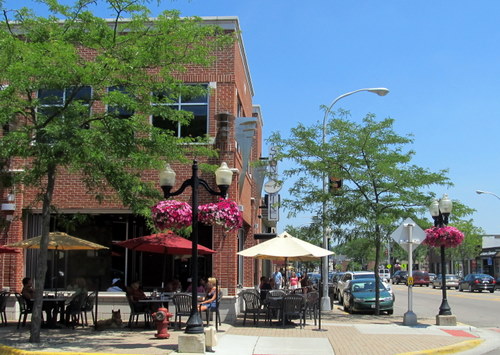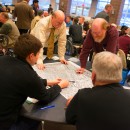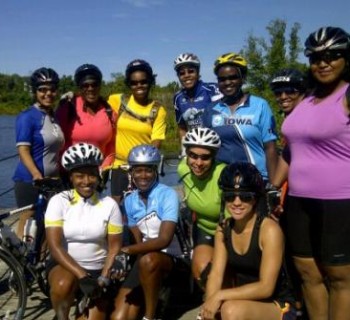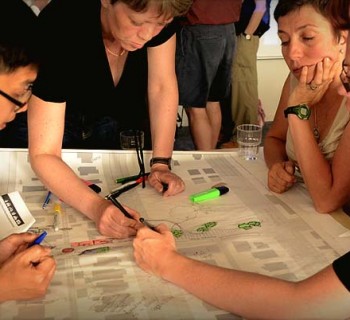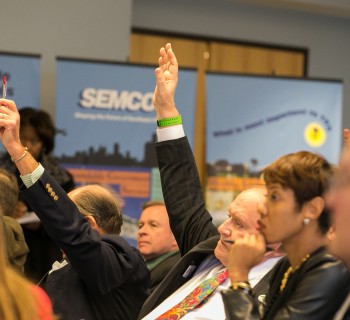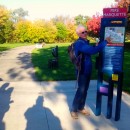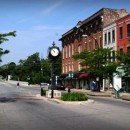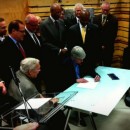Editor's note: This is the fourth part in a series on the 2014 Michigan Transportation Odyssey (MTO).

Automobiles used to rule the streets of downtown Brighton. Over the last two decades though, city leaders have embraced a vision for a less hectic, more walkable business district.
During Trans4M's annual Michigan Transportation Odyssey trip this past October, participants stopped by the Livingston County community for a tour of their handiwork. The group examined a series of lighted crosswalks, a strategically placed roundabout and an intriguing walkway system called a “tridge” to see how transportation enhancements have contributed to to the safety and vitality of downtown Brighton.
The Roundabout

First up on the tour was a roundabout at West Main and Third Street. Simply put, a roundabout is a circular intersection designed so that traffic flows in just one direction. This particular one, the first in the county, was installed in 2003.
Back then, navigating the junction was a major headache. Brighton's leadership felt obligated to fix the situation with a solution that would improve pedestrian safety and increase access to Third Street. The City Council considered putting in a stoplight, but decided a roundabout best fit their needs. An engineering firm called Tetra Tech helped design it, and from there, construction took two months. To mitigate confusion, directional signs and an informational campaign were used to educate the public about the new circular intersection.
Mark Binkley, a member of Brighton’s Downtown Development Authority lives down the street from the roundabout.
"Coming up into town and trying to turn left to the schools this way, it was horrible," he says. “Now that it's here, it works so smoothly. You can't go wrong with it."
Flashing Crosswalks
After seeing the roundabout, the Odyssey checked out Brighton’s lighted crosswalks.
In 2003, a series of pedestrian-vehicle accidents in the downtown area served as a wake up call to city leaders. Walkability expert Dan Burden won their attention with a suggestion to install flashing crosswalks. That idea was then integrated with downtown street plans on crosswalk placement developed by the HyettPalma consulting firm.
The city now boasts six flashing crosswalks: four on Main Street, and others on St. Paul and West North Streets.
Each crossing is illuminated by several pedestrian-activated LED light modules, which are built into the street and accompanied by flashing signs. Curb extensions and colored paver bricks, elevated to create noise as drivers pass by, have also been adopted in spots as additional traffic calming measures.
So far it’s been a success; there haven't been any pedestrian-vehicle accidents at the crossings since the new features have been installed.
"The idea was to bring more attention to the crosswalks than we had before, to make folks--especially pedestrians--feel safer and do a better job of managing potential conflict between pedestrians and traffic," says Brighton City Manager Dana Foster.
The Tridge
The tour wrapped up with the Tridge, a triple bridge spanning Brighton's historic Millpond. The bridge and accompanying boardwalk were dreamed up in a master plan for Millpond Park, developed in 1993. It was designed by the Lindhout Associates architecture firm and built by O'Laughlin Construction, both Brighton firms.
Although funds were tight at the time, city officials forged ahead, believing the plan would highlight an important community asset and encourage foot traffic. Brighton applied for and won a state DNR grant, supplementing this with city dollars and Downtown Development Authority funding.
Although it initially met with some criticism about blocking the view of the pond, Foster says the Tridge ended up being a real catalyst for the downtown.
"It opened up the rest of the Millpond to be truly enjoyed as more of a complete park, [and] it provided another route for pedestrians to get to other points in our downtown.”
Street improvements have helped the city’s business district flourish, according to Foster.
"There wasn't much of a night life here," he says. "Now there's a huge nightlife. During the summer season…downtown is filled, bustling, hardly any parking available, because it’s so packed.”


